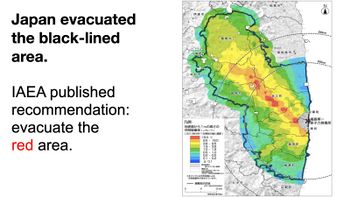Fear of radiation

Fig.1 Exposures up to 100mSv in a short time won't overwhelm our DNA repair systems.[1]

Fear of radiation is one of the barriers to reconsidering nuclear power. Government agencies have for decades assumed that deaths and other bad effects of radiation on our health follow a model called Linear No Threshold (LNT), in which death and disease is directly proportional to the total cumulative radiation, no matter how low the rate, even as low as the normal background radiation from space and the materials around us. This assumption ignores the data on low exposures (Figs.1&2) and the role of DNA repair in mitigating the damage done by low doses of radiation (Fig.3). Without a repair mechanism, the number of DNA breaks would simply accumulate in a linear fashion, no matter how low the exposure.

Fig.3 Natural breakage and repair of our DNA occurs much faster than damage from low levels of radiation.[3]
Reliance on the LNT model has led to policies that are very costly, like radon remediation in old homes (Fig.4) and over-reaction to radiation accidents, like the evacuation after Fukushima (Fig.5), which caused far more deaths than the accident itself (Fig.6). It has also led to excessive fear of radiation from medical x-rays and other nuclear medicine procedures which save thousands of lives.
The LNT model has also been used to argue against expansion of nuclear power. It has lead to the belief that an accident causing a small increase in radiation over a very large area could lead to a large number of cancers and deaths. Nuclear power advocates argue that the danger from a radiation leak is much smaller than the public believes, and much smaller than the risks from ever-increasing CO2 in our atmosphere.
Further Reading
For the pro-LNT point of view, see Hold Fast to Linear No-Threshold for Radiation Protection, Bemnet Alemayehu, Senior Staff Scientist, Natural Resources Defense Council, 2016.[6]
"... numerous authoritative national and international bodies have convened committees of experts to examine the issue of LNT ... Again and again, these bodies have endorsed LNT as a reasonable approach to regulating exposures to low dose radiation. ... Opponents of the LNT model simply chose to disregard core research and findings in the field of radiation health physics."
For a rebuttal to these arguments from authority, and an in-depth review of the history, politics, and science of LNT, see Epidemiology Without Biology: False Paradigms, Unfounded Assumptions, and Specious Statistics in Radiation Science, Bill Sacks, Gregory Meyerson & Jeffry A. Siegel,
Biological Theory, 2016.[7]
"Belief in LNT informs the practice of radiology, radiation regulatory policies, and popular culture through the media. The result is mass radiophobia and harmful outcomes, including forced relocations of populations near nuclear power plant accidents, reluctance to avail oneself of needed medical imaging studies, and aversion to nuclear energy — all unwarranted and all harmful to millions of people."
For a more recent review from the Health Physics Society, see The History of the Linear No-Threshold (LNT) Model, 2024.[8]
"The Health Physics Society (HPS) created this series of videos to examine the history of the most controversial question in our field: the LNT model."
For a summary of the argument that there was scientific misconduct in the promotion of LNT, see Cancer risk assessment, its wretched history and what it means for public health, Edward J Calabrese, Journal of Occupational and Environmental Hygiene, 2024.[9]
"The foundations of cancer risk assessment represent a century of significant uncorrected mistakes and scientific misconduct, dominated by powerful self-interests and politicized ideological actions involving the US National Academy of Sciences (NAS), Science journal, multiple Nobel Prize winners, and elite leaders of the field of radiation genetics from the 1920s to the 1990s." ... "It is time that the scientific community, including [professional associations] inform their memberships and elected leaders of this history of public deception and work to correct the scientific record."
Notes and References
- ↑ Grant 2017 "Solid Cancer Incidence among Atomic Bomb Survivors: 1958–2009" E.J.Grant, et.al., Radiation Research, 187(5):513-537 (2017), see Table 3 for data.
- ↑ See the Kerala Study showing that natural background radiation, even at very high cumulative doses, shows no detectable increase in cancer.
- ↑ See DNA Repair for an explanation of these repair mechanisms and how our bodies respond to DNA damage.
- ↑ Kharecha 2019 "Implications of energy and CO2 emission changes in Japan and Germany after the Fukushima accident", Pushker Kharecha, Makiko Sato, Science Direct, Volume 132, September 2019, Pages 647-653, https://doi.org/10.1016/j.enpol.2019.05.057
- ↑ See The Fukushima Workers Jack Devanney, Substack 6 Nov 2024, for a detailed analysis of the Lost Life Expectancy for the most severely exposed workers at the Fukushima plant.
- ↑ Hold Fast to Linear No-Threshold for Radiation Protection, Bemnet Alemayehu, Natural Resources Defense Council, 2016; accessed September 2024.
- ↑ Sacks, B., Meyerson, G. & Siegel, J.A., Biol Theory 11, 69–101 (2016). https://doi.org/10.1007/s13752-016-0244-4
- ↑ The History of the Linear No-Threshold (LNT) Model, Health Physics Society, accessed July 2024.
- ↑ Calabrese, E. J. (2024). Cancer risk assessment, its wretched history and what it means for public health. Journal of Occupational and Environmental Hygiene, 21(4), 220–238. https://doi.org/10.1080/15459624.2024.2311300


